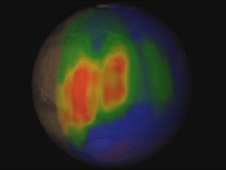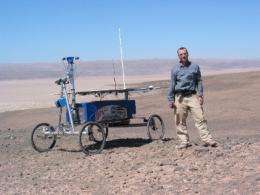Five steps toward future exploration

The NASA Astrobiology Science & Technology for Exploring Planets (ASTEP) program has announced a set of new projects to develop and test technologies that will enable the astrobiological exploration of the Solar System. The ASTEP program advances the search for life on other planets by supporting research and exploration of some of Earth's most remote and extreme places.
ASTEP projects develop novel ways to study how life copes with extreme environmental stresses, as well as test new technologies that address existing questions in the search for life elsewhere. The knowledge gained provides NASA mission planners with the tools they will need to seek, identify, and characterize life that exists (or once existed) on worlds like Mars, Titan, and Europa.
From the Atacama desert in Chile to the Great Slave Lake in arctic Canada to southwest Greenland, the projects involve technologies that will be deployed in some of the most fascinating locations on Earth. As the teams seek to understand the potential for life elsewhere, they will also decipher links between life in extreme environments and the climate history of our own planet, Earth.
Mars Methane Plume Tracer
The Mars Methane Plume Tracer is led by Principal Investigator Donald Banfield of Cornell University, and will provide new information about methane plumes on Mars. In 2004, scientists reported that ESA's Mars Express spacecraft had detected trace amounts of methane in Mars' atmosphere. These methane 'plumes' raised questions about whether or not living organisms could be producing them. On Earth, more than 90% of methane is produced by life. There could be other explanations, such as volcanism or areothermal and hydrothermal vents, but the potential for biology makes studying methane on Mars a major priority for astrobiologists.
Right now, there are a number of missions being considered to detect and study methane plumes from orbit – including the ESA/NASA ExoMars Trace Gas Orbiter. Surface missions to collect samples from the sources of the plumes are also being drawn up by mission planners. However, before these missions can successful, we first have to be able to characterize the plumes and locate their specific sources. That's where the Mars Methane Plume Tracer comes in.
"I think that the Mars Methane Plume Tracer project will result in some key technical strategies to help us get right in to sample the sources of these possible methane plumes," Donald Banfield told Astrobiology Magazine. "Whether they turn out to be biogenic in origin, or volcanic or something else, we're going to need to get up close and personal to really understand them. From orbit, we can likely only localize a plume source on Mars to within a few kilometers. On the ground, we'll likely need to find it within a few meters to actually sample it. In the Mars Methane Plume Tracer project, we'll be developing the technical approaches to enable that in situ navigation from an orbital scale to an in situ sampling scale of plume source localization."
Instruments and techniques developed under this project will improve our ability to localize and characterize plumes from orbit, while instruments and navigational algorithms to guide a slow-moving martian rover to a plume's source will be also be developed and field-tested.
Shallow-Borehole Array for Measuring Greenland Emission of Trace Gases as an Analogue for Methane on Mars (GETGAMM)
Mars methane plumes also take center stage with the selection of the GETGAMM project. This project is led by Principal Investigator Lisa Pratt of Indiana University, and will help astrobiologists understand the origin and potential biological significance of methane plumes on Mars. The results of this work will inform strategies for detecting life associated with methane plumes on Mars.
Pratt's team will use three instruments to measure variations in methane from sources in the bedrock of Greenland. The team will study an area of roughly 1 km2 over three years of sequential field campaigns. The instruments include a multi-path tunable laser spectrometer that is optimized for carbon isotope discrimination (contributed by the Jet Propulsion Laboratory); a cavity ring down spectrometer capable of both carbon and hydrogen isotopic measurements (contributed by a collaboration between Goddard Space Flight Research Center and Princeton University); and a commercially produced integrated cavity output spectrometer from Los Gatos designed for carbon isotopic measurements (operated by Indiana University).
The project is advancing some important mission technologies that could change the way future missions are developed. One important aspect of this development revolves around semi-autonomous technologies that will allow future missions to perform more complicated and intricate scientific investigations than today's rovers and landers. By year three of the GETGAMM field campaign, the sampling and measurements in Greenland will be conducted by a semi-autonomous robotic drilling effort.
The robot will drill to depths of up to 2 meters, and will seal the boreholes behind itself. Next, the semi-autonomous robot will transfer gas from the boreholes to instruments above ground, and without atmospheric contamination. This semi-autonomous technology demonstration will aid in engineering and scientific preparation for a shallow drilling on Mars, which is currently under consideration for the 2018 mid-range rover mission. Understanding methane production at the research site in Greenland will also provide much-needed data about how greenhouse gases are produced on Earth.
Planetary Lake Lander
The Planetary Lake Lander project is led by Principal Investigator Nathalie Cabrol of NASA Ames Research Center and the SETI Institute, and involves a three-year field campaign at Laguna Negra (Black Lagoon) in the Central Andes of Chile. Here the team will test mission scenarios and technologies for deploying a floating, robotic platform that can perform scientific studies remotely while swimming the waters of Laguna Negra. Ultimately, this work will pave the way for a lake lander mission to Saturn's moon Titan. NASA has never attempted a lake landing before, so this field campaign is an essential first step in identifying the challenges that mission developers must contend with when they turn their sights toward the methane lakes of Titan.
"Planetary Lake Lander is a very exciting project since landing on alien seas and lakes has never been accomplished before," said Nathalie Cabrol. "It really pushes the limits of our imagination. If projects like TiME [Titan Mare Explorer] make it to the final selection phase, we should have one such mission very soon."
Because the Lake Lander project is dealing with such new mission concepts, the team will have to use some creative solutions to solve problems not encountered in previous missions. "Our project will try to understand how to optimize operations and exploration, and make such probes smart, adaptive," said Cabrol. "The Lake Lander should be aware of its environment and its changes, and make operational decisions such as sampling and collecting data without human supervision if necessary. This will greatly increase mission return and science productivity."
Not only will the Planetary Lake Lander prepare us for a mission to Titan, but it also will collect data from one of Earth's most fragile environmental systems. Climate change has led to an increase in ice melt at Laguna Negra, and this project will help answer questions about how deglaciation affects the vulnerable ecosystem of glacial lakes.

"Our planet is changing extremely fast," Cabrol commented. "Deglaciation will not only affect human water resources in the coming decades, it will impact the biosphere. We do not understand all the causes or all the effects. In many ways, the rapidity of Earth’s deglaciation confronts us with the same operational scenario as a planetary mission faced with only limited time to understand the environment and achieve its objectives. It makes sense, thus, to use advanced technology and adaptive systems developed for planetary exploration to harvest data as rapidly as we can to improve our future on Earth."
The Planetary Lake Lander will help aid scientists in understanding the effects of climate change on modern systems, and will also provide information relevant to studying similar environmental periods during the history of Earth and Mars.
VALKYRIE: Phase 2
The VALKYRIE (Very-Deep Autonomous Laser-Powered Kilowatt-Class Yo-Yoing Robotic Ice Explorer) project is led by Principal Investigator Bill Stone of Stone Aerospace. This project builds upon the results of Phase 1 of the VALKYRIE cryobot project, currently under ASTEP funding. After successfully studying hardware and obstacle avoidance systems for VALKYRIE, the team is now ready to take their work into the field. They will be testing a small version of VALKYRIE during three field campaigns, one located at Great Slave Lake in Canada and two additional campaigns to the Norwegian island of Svalbard.
The team will use VALKYRIE to penetrate a series of glaciers on Svalbard, reaching depths up to 200 meters. Not only will the project test technologies that could lead to missions on Europa, Enceladus, and the martian ice caps, but Stone and his team will also help scientists on Earth map the ice caves that underlie certain glaciers in Svalbard. VALKYRIE will also deploy sensors in the ice cap so that environmental scientists can monitor the glaciers and the changes they are experiencing due to Earth's warming climate.
Robotic Investigation of Subsurface Life in the Atacama Desert
David Wettergreen of Carnegie Mellon University is Principal Investigator for this three-year field campaign. The team will employ the first autonomous survey rover capable of drilling beneath the ground to collect samples. Life on Earth thrives deep under the surface of our planet, and many scientists believe that the best place to find evidence of past or present life on Mars lies deep underground. Wettergreen and his team are helping to make drilling missions possible by testing a rover capable of drilling, collecting, and analyzing samples in the Atacama Desert of Chile.
This project will establish drilling as a field-proven capability for science rovers, but it will do more than advance technologies for future missions. The rover will also provide important information about how life in the Atacama has adapted to harsh conditions like a severe lack of water, increased oxidation, and high salinity. The surface environment of the Atacama is an extremely harsh place for life as we know it, and this project will see how those harsh conditions impact habitability below ground. The data will expand on the Life in the Atacama (LITA) project, and will also help astrobiologists understand what the Atacama can teach us about the potential for past and present life on Mars.
The Next Three Years
With the selection of five new NASA ASTEP projects, NASA is a step closer to obtaining the necessary technologies for new and truly novel planetary exploration missions.
ASTEP field campaigns are conducted with complete systems, and the teams undertake their work as if they were conducting operations during actual planetary missions. By taking this approach, the ASTEP program gives astrobiologists real operational experience, providing a better understanding of how technologies will perform when conducting real science in extreme environments. They also provide unique opportunities for communicating with the public about the important science that NASA performs, both in space and here on Earth. Stay tuned to Astrobiology Magazine as we report on the work performed by the new ASTEP teams, along with all the challenges and successes they encounter while conducting astrobiology research in the field.
Provided by Astrobio.net




















